(Before we start, my Black Friday post will hit tomorrow and be updated throughout the week. This listing attempts to as best as possible take into account those price changes.)
It’s that time of year where tons of folks are looking at gadget options – either for themselves or for friends and family. For many years I’ve put together a list around November with my gadget recommendations. My goal here being to give my specific recommendations – exactly the same recommendations I’d give to my own friends and family.
This post isn’t here to list every option on the market in an effort to make every manufacturer happy. Nope, it’s a clear cut ‘what I’d buy’ for certain use cases. Of course as more and more companies get into the market, there ends up being more and more possible scenarios as the products expand in functionality.
Now this past June I put together a Summer recommendations guide, but since then a lot of stuff has changed in certain markets. Meanwhile, in other areas nothing has changed – for example, cycling computers remains identical to what it was this summer. For those that are familiar with my summer recommendations, here’s the sections that have changed in this post:
– Triathlon watches
– Running watches
– Action cameras
– Activity trackers
All other sections remain unchanged.
If you’re looking for a listing of what I use day to day, check out my ‘Gear I Use’ list, as well as The Girl’s list too (both of which will have updates this week, though, fairly minimal changes).
Finally, if you use either the Amazon or Clever Training links, you help support the site. I’ve partnered with Clever Training to offer all DC Rainmaker readers exclusive benefits on all products purchased. You can read more about the benefits of this partnership here. You can pickup most devices below through Clever Training using the links in the tables. By doing so, you not only support the site (and all the work I do here) – but you also get to enjoy the significant partnership benefits that are just for DC Rainmaker readers (like saving 10% on non-clearance/deep-sale items). And, if you are picking up items that are more than $75, you can get free US shipping as well.
With that, let’s dive into it!
Running GPS Watches:
Road Running – Best in Class: Garmin FR620
It used to be that I used the Garmin FR610 for all my running adventures, but since the FR620 came out last fall, I’ve been using it instead – and it’s working great for me. Garmin listened when it came to waterproofing, connectivity via Bluetooth to your phone, and customization. It’s pretty much my perfect running watch. There’s simply nothing else in the same ballpark from a functionality standpoint by other companies. And, with the FR620 cycling mode functionality added this summer, it brings the much requested functionality back to the lineup.
Many will ask why the FR620 over the FR920XT? It’s true the FR920XT has more functions – a lot more. But for some, including me, I really do like the super slim aspect of the FR620 over the bulkier FR920XT. That said, I’ve been using the FR920XT over the last few months and I might be slowly switching to that as a running watch. We’ll see…
Trail/Ultra Running – Best in Class: Fenix2, or Ambit 3 on sale.
This category covers units with barometric altimeters as well as longer battery life. Both of the options I note below contain a ‘long battery life’ mode, which reduces the number of GPS points recorded (through a variety of means).
Last year I ‘awarded’ this category to the Ambit2 over the Fenix(1), because of the versatility the watch had in connecting to cycling sensors as well as being able to do pool and openwater swimming. But I noted at the time that the Fenix had more when it came to hiking and navigation – but lacked in other areas.
Since then though not only has the Fenix2 come out but they greatly expanded the feature set and even went back and added in a ton of Bluetooth related features to the Fenix1. At the same time, Suunto has added in a handful of features while also filling the biggest gap I saw at the time: Inability to get proper data to 3rd party sites (for example, by adding automatic sync with Strava, and .FIT file export).
So to that end this is still a slightly tricky category. But I’d kinda put my recommendation as such: If you can get the Ambit3 at a lower price then that’s still a choice. But if it’s at a higher $500+ price, then go with the Fenix2. Said differently: I don’t believe the Ambit3 is worth the high-price they’ve set for it. But I do believe the watch is much more competitive about $100 cheaper, making up for the lack of features found on the Fenix2.
Running – Moderate/Mid-Range: Polar M400
This is the first time in years that Garmin has lost the coveted best mid-range running watch to another company. It was held last year by the FR220, but with the Polar M400 being far cheaper than the FR220, and having more flexibility, and more features – it was an easy choice.
The FR220 sits at $249, whereas the M400 is $179. Both have good running features, but only the M400 also includes a daily activity tracker for measuring steps when not in a workout, and sleep metrics at night. The M400 also supports a slew of sport modes that you can fully customize, and they’ve got footpod support planned for the next month or so – rounding out treadmill use. Like the Garmin it can upload via your mobile phone to Polar Flow, their training log site. The site recently announced 3rd party compatibility options, and a number of major 3rd party sites are already working on connectivity to Polar.
Ultimately though, the price is the biggest ticket here as to why it’s the winner. At $70 cheaper, it’s a no-brainer.
(Update Nov 2015: One thing we have seen a spike in during 2015 is failures of the USB port, primarily due to corrosion. Interestingly, in the October timeframe we started seeing Polar ship a slightly different USB port arrangement on the M400’s. Whether or not it fixes things is still to be determined. On the bright side, Polar has swapped out pretty much everyone’s units without question.)
Running – Budget Range: TomTom Runner (or FR15 on sale)
The TomTom Runner with its new $99 sale price has easily moved into the top spot here. It’s able to track your runs, has some basic structured workout functionality and alerting options, as well as can upload via your mobile phone. Plus, you’ll get more display customization on the TomTom series than you would on the Garmin FR10/FR15 watches.
Now, in the event the FR15 goes on sale, then it’s definitely worth considering again especially since it has daily activity tracking (steps), which the TomTom doesn’t. The challenge is that at regular prices of $169, it’s only $10 cheaper than the above Polar M400 – which is a far better deal. So the price has to drop quite a bit to really be a contender here.
If neither unit is on sale, then I’d still go back to looking at the FR10, which floats at around $129US. It lacks heart rate or activity tracking found in the FR15. But beyond that virtually everyone who purchases one is happy with it (judging by 600+ comments on my review post).
| Product | Amazon | |
|---|---|---|
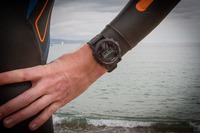 | Garmin Fenix2/Fenix2 SE $399 | Amazon |
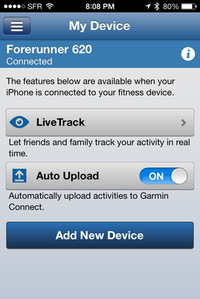 | Garmin Forerunner 620 $399 | Amazon |
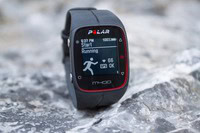 | Polar M400 $179 | Amazon |
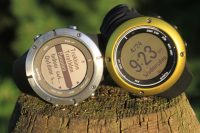 | Suunto Ambit2 $319 | Amazon |
 | Suunto Ambit3 Peak $499 | Amazon |
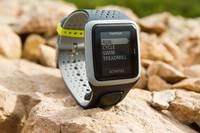 | TomTom Runner $99 | Amazon |
Triathlon GPS Watches:
This category is for what the industry calls ‘multisport’ watches, but that typically just translates to triathlon watches. They track your time/distance/etc… within the three sports – swim/bike/run. From a non-triathlon multisport aspect, these watches are often used by everyone from wind surfers to rollerbladers, mostly because of their versatility and flexibility in configuration and display customization.
Back in June, I noted that it was a poor time to purchase a new multisport watch. Now that we’ve had two new watches hit the market, you can easily see why. Both the Garmin FR920XT and the Suunto Ambit3 arrived, and the Polar V800 has seen some solid updates, like indoor swimming in the last few weeks and power meter support the previous month.
Overall Best in Class: Garmin FR920XT
Despite those updates though, there’s really no competition here at this point. The sheer volume of features found on the FR920XT dwarfs that on even the V800 and Ambit3. While I think Polar has the longer term option of catching up with consistent new firmware updates to the V800, I think the hardware limitations of the existing Ambit3 platform make it difficult for it to hit the same level as either the Garmin or Polar units.
When it comes to new features in the FR920XT, it’s essentially pulling the ‘best’ features found on all the other new Garmin fitness devices over the past 3 years into a single watch. Everything from live tracking via phones to daily activity tracking (i.e. steps/sleep) to new swim interval timer modes and tons more. While I could list all the new features here, it’d really just be redundant with my previous ‘What’s new’ section, as well as the full In-Depth review. Perhaps what I think may be the most important feature though is Connect IQ, which means that developers will be able to start releasing apps for the FR920XT, allowing you to add functionality that perhaps Garmin hasn’t.
Of course, there are some areas I’d still like to see them focus on – such as courses and the barometric altimeter calibration. But for most triathletes, those are likely to be of less concern in daily training or even most races.
Budget Options: Suunto Ambit2 S, and in some cases FR310XT
At the budget end, you’ve got the Ambit2 S, which sits at $219US these days. That’s a very solid deal for a watch that tracks across all three sports – including laps in the pool. Plus, Suunto’s addition of standard export capabilities over the last year mean that it’s easy to get these to the platforms and apps you’d like, including direct connection to Strava. Plus, it looks like a normal watch and can be worn day to day as a regular time watch as well.
If you want to save a bit more, you can pickup the Garmin FR310XT. It hovers around $175US, and has the vast majority of the FR910XT functionality. The core areas that both it lacks compared to the Suunto Ambit2 S though are indoor swim tracking, as well as stroke metrics for outdoor swimming. The FR310XT has a variant of openwater swim mode to be used on the wrist, though accuracy isn’t as good as the Ambit2 S. If you’re just getting into triathlon and aren’t quite sure what your plans are – I’d really recommend the FR310XT over the higher end watches. But if you can afford the extra $50 for swim tracking and the ability to just use it as a regular day watch, I’d go the route of the Ambit2 S.
| Product | Amazon | |
|---|---|---|
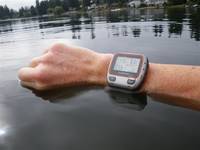 | Garmin Forerunner 310XT $170 | Amazon |
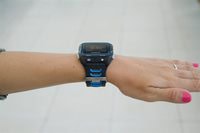 | Garmin Forerunner 920XT $249 | Amazon |
 | Suunto Ambit2 S $219 | Amazon |
Cycling GPS Units
As I’ve noted previously, anytime someone in the cycling/sports technology industry starts a conversation about bike computers, it always starts with “it’s like the Edge 500”. Well, there’s reason for that. Given the Edge 500’s current prices at $200, it’s still an awesome deal. If you don’t care about maps and turn by turn navigation, you won’t find a better unit out there. Plus, with all Garmin devices pushing automatically to sites like Strava, Training Peaks and more – it’s hard to beat that connectivity.
Meanwhile, CycleOps has the Joule GPS, which…’is sorta like the Edge 500’, except from CycleOps. Importantly though, it does more around historical power metrics (like showing your 5min power max, weekly and monthly maxes, etc…). Many folks like it just as much as the Edge 500.
Finally, the O-Synce Navi2Coach is very solid, and I’d have no problems using it day to day either. We haven’t quite seen as many updates to the unit as we did during the initial release cycle – but most people seem quite happy with it. About my only complaint there is (still) the mount, which can be prone to breakage.
If you want turn by turn navigation (like a car GPS), there’s not a ton of choices. You’ve got a few Garmin units (Edge 810, 800, Touring), and then the Mio Cyclo units.
Last fall I recommended the Edge 800 over the Edge 810, as I felt the features didn’t justify the extra price. And in many ways I still feel the same way. However, the ability to upload via Bluetooth is becoming more relevant with Garmin’s new automatic sync partnerships (like Training Peaks, Strava, SportTracks, and MapMyFitness). Within the course of a few short months these partnerships covered all the major players in the game.
Meanwhile, you’ve got the Mio Cyclo 505 (also branded as Magellan). That unit received a substantial firmware update this past fall that added in a ton of features. For example the ability to control trainers and Shimano Di2 integration. These were features that Garmin didn’t have at the time, though have since been added to the Edge 810 and Edge 510. That’s why the Mio is slowly sliding out of contention here, but I’m keeping it for the moment as a very viable alternative.
There are some minor nits though with it that may cause more serious cyclists to pause – specifically the lack of a lap function, insufficient power data recording, and the inability to put together workouts. The lap piece is coming down the road in a future firmware update, so that should help there. And, I don’t find the interface as polished as the Garmin Edge 810, though that’s a lesser issue. But I do think over time Mio will be able to play catch-up in a lot of areas. No doubt that I see them as Garmin’s biggest competitor.
So why not the Edge Touring? In many cases the Edge 800 isn’t all that much more expensive than the Edge Touring. And the Edge 800 has far more functionality than the Edge Touring does, except in the area of round-trip routing (whereby you tell the unit you want a 50-mile ride and it goes and creates a random route). The Edge 810 lacks that as well. Meanwhile, the Touring lacks 80%-90% of what either the 800 or 810 has. So if you’re looking to save some cash, go Edge 800 instead of Edge Touring.
Budget GPS Option: Garmin Edge 200 or RFLKT+
If you’re looking for a budget option that records your route, your first and best bet is actually your phone with a free app like Strava, MapMyRide, Wahoo Fitness, or similar. If however you want more of a small handlebar unit, then the Edge 200 is where it’s at. While I’ve been playing with some other options, ultimately, at $129 it comes down to the Edge 200 being the cleanest interface and the easiest to upload to Garmin Connect (or any other site you’d like, they all support it).
You also do have the Wahoo RFLKT and RFLKT+. These units require your smartphone be on you at all times, as they display data directly from popular apps, sorta like a dashboard. It’s a bit cheaper than the Edge 200, and gives you a bit more flexibility because the apps allow you to easily pair sensors like heart rate and cadence sensors.
| Product | Amazon | |
|---|---|---|
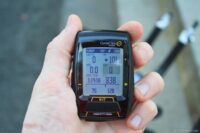 | CycleOps Joule GPS $220 | Amazon |
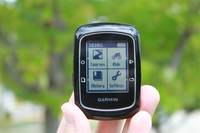 | Garmin Edge 200 $129 | Amazon |
 | Garmin Edge 500 $199 | Amazon |
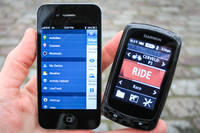 | Garmin Edge 810 $399 | Amazon |
 | O-Synce Navi2Coach $249 | Amazon |
Cycling Power Meters:
Choosing a power meter is a tough decision matrix. Anyone who answers the question “Which power meter should I choose?” and instantly names a specific brand name/model upfront, is full of crap. The correct answer is “Tell me more about your usage plans?”
There are so many variables that go into that decision beyond just price. For example: How many bikes? What type of bike? What type of pedals? Do you want to move it around a lot? Race wheels or not? What do you want to measure? And on and on.
The good news is that I cover these in-depth in my Power Meter Buyer’s Guide from this fall. Nothing has changed there since then (neither in products nor in my opinions), and I don’t expect any shifts in the near future.
Cycling Trainers:
The best way to cover this section is to go read my complete 2014 cycling trainers guide, so again like power meters, I’d go over and and check out that post for all my recommendations (a massive list on a slew of categories). Plus, just on Friday I posted my massive Trainer App guide.
Obviously, given it’s now basically the trainer season, there’s no more trainers coming out till at the earliest mid-next year, with most announcements typically happening at Eurobike in August each year.
Swimming:
MP3 Players: FINIS Neptune + See MP3 Player post
There’s a lot of options in this category. Some are good options by reputable companies. Some…are crap knockoffs. I’d really encourage you to read my Swimming MP3 Player Shootout post to get all the details on many of the units out there.
The one new unit to the market though that I’ve reviewed since is the FINIS Neptune MP3 player. I did this back last summer and really liked the unit. And many of you as readers who have picked it up have said the same. Thus, like I concluded in my post, if I were looking at an MP3 player these days, I’d be sticking with the Neptune.
Again though, read both the Neptune review and the MP3 Player Shootout post.
Pool Swim Watch: Garmin Swim
There are a handful of options in this category, but I don’t think there’s any real discussion that the best isn’t the Garmin Swim. While the FINIS Swimsense was a good option at one point, it’s sorta beyond it’s prime. You’ve also got the Poolmate Pro and HR, which, are a bit more clunky than the Garmin Swim. The Poolmate HR does do heart rate, but for the life of me I can’t get that strap to stay put on my chest during flip turns (and no, I’m not going to wear a shirt over it at the pool).
Thus, the Garmin Swim. The unit measures your laps and distance, and can be configured for drill mode as well. Afterwards it uploads the data to Garmin Connect, and a variety of 3rd party sites support it as well. Note that it won’t measure outdoor swims, just indoor – as it depends on an internal accelerometer to figure out each time you hit the wall of the pool.
Openwater Swim Watch: There’s no good answer.
Quite frankly, there isn’t a specific outdoor swim watch that I’d recommend. The closest there is comes from FINIS in the Hydrotracker, but I wouldn’t recommend it. It’s overpriced and I found it prone to error. Honestly if you just want to track where you went, grab a cheap GPS unit and stuff it in your swimcap. Alternatively, if you’ve got a bit more money to spend, any of my triathlon swim watches above will measure swim distance outdoors within about 10-15% while on your wrist.
| Product | Amazon | |
|---|---|---|
| FINIS Neptune Swimming MP3 Player $139 | Amazon | |
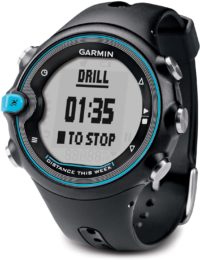 | Garmin Swim $150.00 | Amazon |
Sensors and Mounts:
If you’re getting any of the units listed above, you may be in the market for accessories. Obviously, some bundles include accessories, while others do not. Here’s what I recommend based on having entire buckets worth of accessories to test with.
Before I get started, I’ll note that when possible I’d highly recommend folks buy dual ANT+ & Bluetooth Smart (BLE) sensors. These are available in almost all categories now. The reason for going dual is simple: It allows you the flexibility to choose whichever device you want and know it’ll work with it.
Dual Heart Rate Strap: Wahoo TICKR or 4iiii’s Viiiiva
The Wahoo TICKR is new on the scene, while the 4iiii’s has been around a while. The TICKR (regular edition) is a simple dual ANT+/BLE strap. Whereas the 4iiii’s does the same, but can also bridge ANT+ sensors over to supported Bluetooth apps on your phone. So in that respect, the Viiiiva does more cool stuff, but does cost a bit more.
You’ve also got the Wahoo TICKR RUN, which builds on the base TICKR by adding in the ability to measure pace/cadence without a GPS (i.e. treadmill), as well as give a look at running efficiency type numbers. I’d have no problems recommending that for runners (but it wouldn’t be of any use to cyclists). Now, I’d be cautious on the TICKR X though, I think there’s a lot of misunderstanding into what it does. It doesn’t integrate with watches from the standpoint of being able to save your heart rate and upload it to the watch. It only works with the Wahoo App there.
Optical Heart Rate Sensor: Scosche RHYTHM+
This has become my primary and singular running heart rate monitor (when not testing something else). I just love it. While I liked the Mio Link wrist straps, I’ve found the signal too weak in some cases and then also not quite as stable as the Scosche from a measurement standpoint. Like the Link, the Scosche is dual ANT+/Bluetooth Smart, so it can transmit to just about anything.
Dual Speed/Cadence Combo: Wahoo Blue SCv2
Over the last month or so, Wahoo has come out with the v2 of their BlueSC, which includes both ANT+ & Bluetooth Smart. Thus, two for the price of one. I love this model though because of the quick release bands making it easy to move between bikes if you need to.
If however, you’re looking for a cheaper option, just simply pickup the Garmin GSC-10 – which usually hovers around $30-$35.
Speed-Only (ANT+): Garmin Speed-Only Sensor
This new little sensor is perfect if you only want speed. It requires no magnets and no zipties, and just simply clips on your back (or front) wheel. I wrote up a thing on it here rather recently.
Cadence-Only Sensor (ANT+ or BLE): Wahoo RPMv2
I’ve been using this in tests since it came out last spring, all without issue. It’s a small pod that attaches to the side of your bike crank and it transmits on both ANT+ and Bluetooth Smart, so you can use it with your Garmin device or your smart phone.
ANT+ Footpods: The Timex, Suunto, and Garmin mini-footpods (whatever is cheapest that day)
As long as you pickup any of those three above they all work the exact same way and all function with any ANT+ device. In other words, just pickup whatever is cheapest that day. Ensure that you aren’t picking up the giganto footpods of yesteryear.
If/when in doubt, check out my post on ‘All you ever wanted to know about the ANT+ footpod’.
Bluetooth Smart Footpod: Adidas miCoach Bluetooth Smart Footpod
For Bluetooth Smart footpod capable devices or apps, I’d go with the Adidas one. It’s the smallest BLE footpod on the market and works great with most devices.
Bike Computer Mounts – Garmin quarter-turn Edge (and Forerunner 310XT/910XT/920XT) cycling mount: Barfly TT and Road Mounts
I love my Barfly, specifically for triathlon, the TT/Aero Barfly. I reviewed it back here, but it just works perfectly. While K-Edge does make some great (and really darn sturdy) mounts for Garmin units, I simply don’t think your Garmin unit needs that much mount durability to justify the price.
| Product | Amazon | |
|---|---|---|
 | 4iiii Viiiiva $79 | Amazon |
 | Barfly Tate Labs Road Bike Handlebar Mount $25 | Amazon |
 | Barfly Tate Labs Timetrial/Triathlon Bike Mount $37 | Amazon |
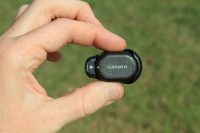 | Garmin ANT+ Running Footpod (Mini) $45 | Amazon |
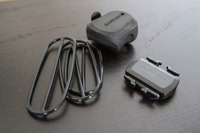 | Garmin Speed-Only ANT+ Sensor (magnet-less) $39 | Amazon |
 | Scosche RHYTHM+ $79 | Amazon |
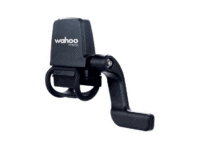 | Wahoo Blue SCv2 - Bluetooth Smart/ANT+ Speed/Cadence Sensor $59 | Amazon |
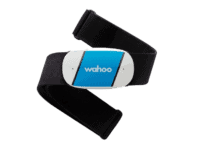 | Wahoo TICKR (Original) $49 | Amazon |
Weight Scales (Connected)
Best Options: FitBit Aria or Withings WS-30 & WS-50
I’ve been including little snippets of these scales in my FitBit Zip and Withings Pulse reviews. Overall, either scale is a solid option and really just depends on if you’re aligned to either of those platforms already (FitBit or Withings). If not, poke at the slight differences with 3rd party partners, and see if either of those partnerships matters. Failing that…flip a coin.
Seriously – they’re near identical scales (exempting the more advanced WS-50 with pulse and air monitoring). Any only relevant differences are partnerships or platforms. And, again, they’re both great scales.
Now, what about ANT+ scales? At this point I wouldn’t recommend them. Garmin (being the only company that ever enabled uploads to devices from them), has pretty much killed off support for them in new devices going forward. Thus buying one of these scales at this point would be kinda silly. Plus, with the exception of the low-end ones, I’ve felt for a while now that the high-end units are a wee bit overpriced.
| Product | Amazon | |
|---|---|---|
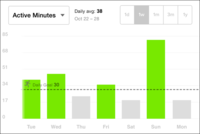 | FitBit Aria WiFi Weight Scale $129 | Amazon |
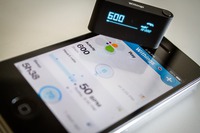 | Withings WS-30 WiFi Weight Scale $99 | Amazon |
 | Withings WS-50/Smart Body Analyzer WiFi Weight Scale $149 | Amazon |
Activity Trackers:
Let me be clear – this is a category that’s in a huge state of sea change right now, and especially over the next 45-60 days. There’s a ton of recently announced new/revamped models either days away from being available (i.e. Basis Peak, Fitbit Charge, Jawbone UP3, Withings Activite), and those that won’t hit till early 2015 or so (Fitbit Charge HR, Fitbit Surge, Apple Watch), plus other recent new on-market options like the Microsoft Band and Jaybird Reign.
As a result of all this churn, what you’ll see over the next few weeks is existing units dropping in price. This is partly in response to new models, partly due to holiday sales, and partly due to clearance ahead of new models at CES the first week of January.
In general, if I was looking at purchasing a unit right now – I’d stick to one of the ones being sold for cheap. I think there’s too much uncertainty at the higher end of the market with too many new companies introducing products that simply don’t do what they say they’ll do. Be it beautiful touchscreen displays on some new activity trackers that don’t work when you sweat, or optical HR on others that don’t work during a workout. A lot of companies are pumping optical heart rate sensors into these units, but not a lot of them actually work accurately.
Said differently, tread carefully with models that are just showing up over the next few weeks. And, expect to see my pop out thoughts on most of the above as they arrive over the next few weeks (many of which are scheduled to show up this week).
Activity Tracker – Athlete: Polar Loop or Garmin Vivofit
Both of these units are very solid, and both of them allow you to connect to heart rate straps to get more accurate calorie data when doing non-step related activities. I’d really say the choice simply comes down to whether or not you’ve got Garmin stuff already or got Polar stuff already. The differences between them are teeny-tiny.
If you can get the Vivosmart on sale, that’s definitely an option as well. You’ll lose some battery life there, but you’ll gain smartphone notifications and the ability to pair it to a cycling speed sensor. On the flipside, not having to charge the regular Vivofit is really just awesome.
Activity Tracker – Budget: FitBit Zip
Finally, when it comes to the budget selection – the $49 FitBit Zip is about as perfect as it gets. It gets some 6-8 months of battery life and then uploads via Bluetooth Smart in the background to your phone. I wear it near-constantly and just don’t have to think about it. It just works…perfectly.
So why the FitBit Zip over the Misfit? Well, for me it’s one simple reason: I want a screen. I think being able to glance at the number of steps without having to look at your phone is meaningful and a motivator. Obviously, some feel differently.
| Product | Amazon | |
|---|---|---|
 | Fitbit Zip $59 | Amazon |
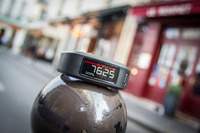 | Garmin Vivofit $49 | Amazon |
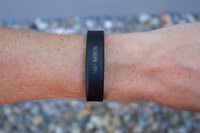 | Garmin Vivosmart $169 | Amazon |
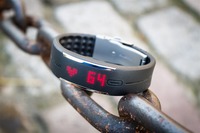 | Polar Loop $55 | Amazon |
Action Cameras:
The action camera market continues to get more and more crowded, seemingly each week. But for the most part, you can divide cameras up into ones with good clean user interfaces and good software suites, and then cameras with clunky user interfaces and lacking/poor software suites.
Over the past month or so we’ve seen GoPro release a trio of new models, while at the same time I fully expect to see a flood of new action cameras at CES in the first week of January (as is customary). Obviously, since GoPro does annual releases and they just put out theirs last month you won’t see anything new from them till next fall. But the rest of the industry should respond then – both at the new ~$100 budget action cam range, as well as the more expensive $500 level.
Action Cams – Best Quality: GoPro Hero4 Black
When it comes to high quality 4K footage, it’s hard to beat the GoPro and the ecosystem there – especially on the mount side of the equation. The size also has remained the same, which is great for both convenience of placement and compatible 3rd party solutions.
That said however, I wouldn’t recommend it as the best overall action cam option for most people. That’s because despite being the most expensive, it’s also the one with the lowest battery life – barely breaking an hour. If you’re looking at GoPro’s specifically, I’d look at either the Hero4 Silver, or, one of last year’s Hero3+ Black models on clearance somewhere.
Action Cams – Budget: Garmin VIRB (base)
This unit is floating between $99 and $129US, which makes it the same price as the new 2014 Hero Base (or cheaper). Plus, it’s got a ton more features than the GoPro has. While it’s a little bit bigger than the GoPro, the handy LCD for framing your shot as well as the fully complete timelapse modes and ability to use it with VIRB Edit easily (software app) make it an easy choice for those looking to save money.
Finally, it has more picture and video resolutions than the GoPro Hero base does along with having a battery that you can can remove (the GoPro Base doesn’t), so if you want to get a spare battery for those long ski days, you can do so.
Note that while a handful of retailers are showing the product is discontinued, I wouldn’t worry much there. While true that VIRB based production has ceased, Garmin continues to pour resources into the platform – including new partnerships and software updates announced in the past few weeks. I’d have no qualms about purchasing a unit at $99 or so these days.
Action Cams – Those wanting GPS/sensor data: Garmin VIRB Elite
I’m really liking this action cam. I’ve been using it constantly for all sorts of things over the past year and am really impressed by it in scenarios where I want to show what I was doing from a GPS map standpoint and/or ANT+ data sensors (for example, my cadence, heart rate, etc…). The VIRB Edit software is also surprisingly good, and Garmin has been publishing software updates since release adding an impressive array of functions. Yes, the camera is slightly more oblong than the GoPro, but it’s also waterproof out of the box, and the record button is easier to use when mounted in strange places. Plus, the ANT+ remote control option via your Garmin Edge unit is really damn cool (to start/stop recording of video directly from your Edge).
All that said, the core reason I’d recommend the VIRB over the GoPro is if you plan to overlay data onto videos. If you don’t plan that, then there are few reasons to go the route of the VIRB (albeit, much better battery life of the VIRB is one of them). I discuss all the detailed pros and cons of VIRB vs GoPro at the end of my Garmin VIRB In-Depth review.
Oh, and for those curious – why not the Shimano CM-1000? Well, while it’s a great little camera, they’ve failed at the one job they had to do: Bring out the software app to actually overlay the data. There’s almost no point in buying that camera without that software. And they’ve been promising it since summer without delivery. Even if they delivered it tomorrow, the camera itself has seen no other updates. This is in comparison to every other action camera on the market seeing either regular software or firmware updates.
Action Cam Mounts: K-Edge Action Cam Mounts
Now, while I prefer the Barfly for my Garmin Edge, I really prefer the K-Edge mounts for my action cams. In doing all my testing lately I’ve come to love the sturdiness of the K-Edge mounts. It’s hard to explain to someone how incredibly rock-solid these mounts are until you attach a camera to them and don’t even get a sliver of a millimeter of sway on them (unlike a stock mount). Incredible. I just bought a bunch more to use with all sorts of cameras. You can literally hang a full blown DSLR on most of these.
Action Cam Flying Mounts: DJI Phantom 2
I’ve been slowly sneaking in shots into various posts from the DJI Phantom 2 over the past few months since purchasing one, and thus far loving it for use with the GoPro. With a bit of creativity you could probably get some other action cams to mount on it, but you wouldn’t get the stability you get with the GoPro (I’d love a well made VIRB mount for it). I shot a bunch of stuff in New Zealand with it and the GoPro series within my GoPro Hero4 In-Depth review.
As an aside for those interested, the 3DR Iris+ just arrived as well last week and I’m starting to poke at that a bit. In some areas it exceeds the Phantom 2 from a usability/functions standpoint, while in others it’s a bit funky.
| Product | Amazon | |
|---|---|---|
| DJI Phantom 2 (for GoPro) $699 (+ mounts) | Amazon | |
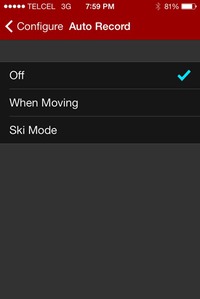 | Garmin VIRB (Elite) $299 | Amazon |
 | Garmin VIRB (Normal) $99 | Amazon |
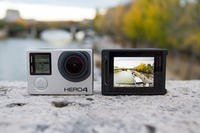 | GoPro Hero4 Black $499 | Amazon |
 | K-Edge Action Cam Mounts Varies | Amazon |
Don’t forget the Comparison Tool!
Ok, lots of recommendations. If there’s a category I’ve missed (entirely plausible) – just drop a note in the comments and I’ll try and come up with a recommendation and add it above.
More importantly though, you can mix and match just about everything I’ve talked about above, with in-depth comparison tables over at the product comparison calculator, which today supports: Action Cameras, Heart Rate Straps, Watches/Bike Computers, Power Meters, Activity Monitors, and Trainers.
Select product use/budget for a comparison from the drop down menus:
Note: While many running watches have a basic bike mode, only running units that are multi-sport focused are also included in the bike-only results (in addition to bike-specific units). Hiking units are those that include a Barometric Altimeter, Magnetic Compass and navigational functions.
Or select products for comparison by clicking the product boxes below:
As always, thanks for reading – and supporting the site!

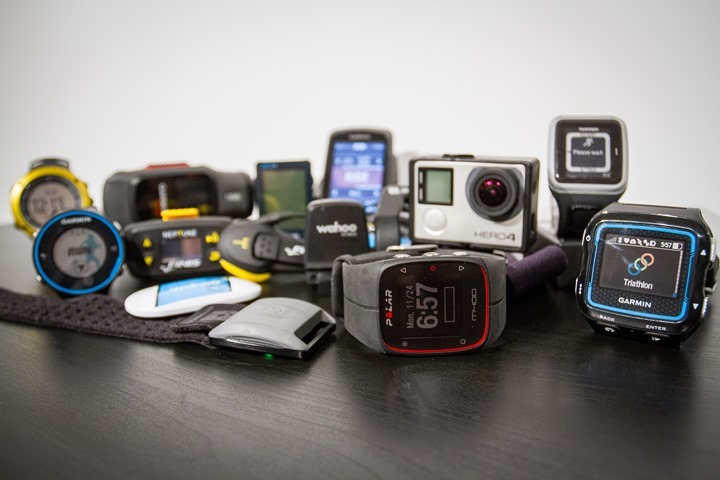

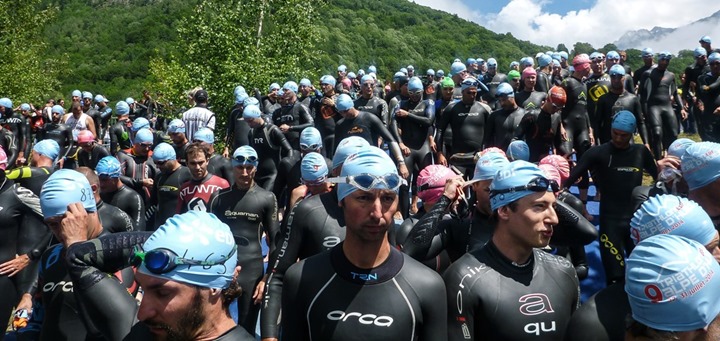
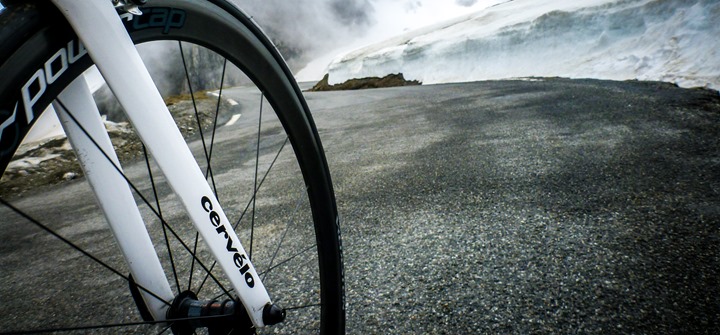


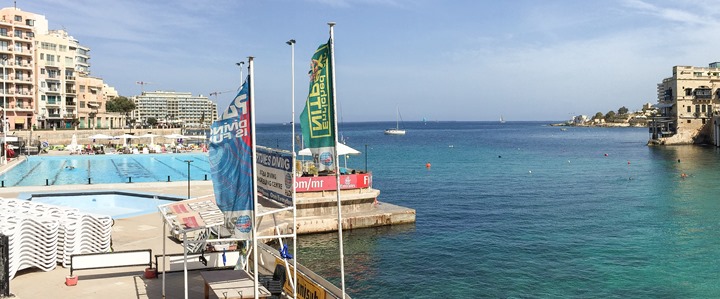
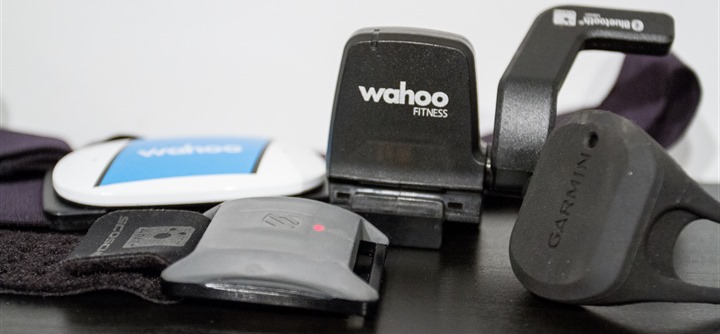

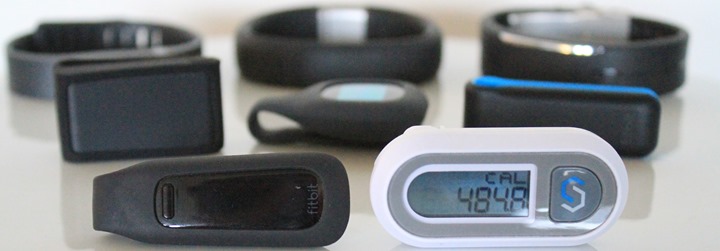
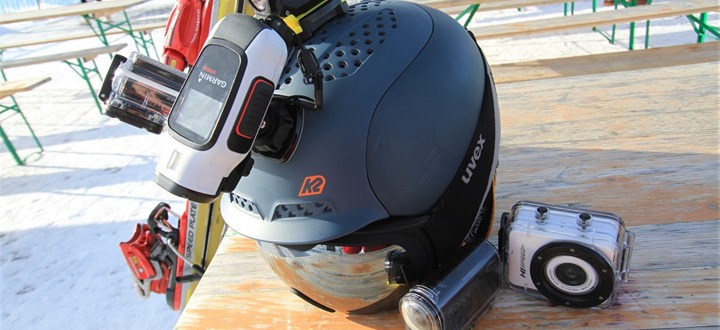

















Hi – read all your reviews which are all very detailed. Still can’t make my mind up, can you please help ?. I’m looking for an “all in one” HR + GPS, activity tracker –
30% outdoor running, my 7 year old Garmin takes about 15 minutes to lock sats – arrrgh – so quick satellite fix and relatively accurate HRM
20% indoor running – would like to just monitor HR and estimate calories burned
20% indoor spinning – would like to monitor HR and estimate calories burned
40% weights, HIIT, Circuit, kettle bell classes and other indoor activity – again would like to monitor HR & calories.
Finally I’m just 5′ tall and have pretty small wrists.
Can you recommend the best unit – not looking to monitor sleep patterns or any of that – purely for exercise. Budget not really an issue. Whilst typing this just seen the Apple watch ad on TV which looks cool but don’t want to lug around my phone iPhone 6 …
Tom Tom Multisport ? – please help !!! thanks.
The TomTom doesn’t do activity tracking, so that’s one’s probably not ideal if you want that.
You might be best waiting a few more weeks for the recently announced FR225.
Hi,
I am new to the GPS watch world and have thoroughly enjoyed your website so thank you. I really like the Fenix 3 because I am in the military and do a lot of running, but also could use the compass and several of the other features and the battery life. However, I cannot afford it right now. I know that right now the Fenix 2 can be bought for $239 at a few places. However, I also like the M400 and it is even cheaper (~$149). I am intrigued by the smart notifications since I am not allowed to have my phone out in class but I read that the F2 battery drains really quickly with the smart notifications and the M400 should be getting them soon. The watch will likely be used 75% for running 25% for hiking (but most of that will be on trails where I know where I am going). Should I get the M400 now and wait for the F3 price to drop or go on sale down the road or should I go for the F2? Thanks for your advice.
I started cycling last year, using my smart phone as both an mp3 player and GPS tracker (using Strava), but as my rides have become longer, battery life has become a serious problem. I also want to start tracking my runs, but running with my big Note 3 bouncing around is a pain. I found thesportgps.com on reddit. It looks like it will be good for both my running and my cycling since it’s an mp3 player and a GPS watch and the battery life is much longer than my phone. Have you heard of this? Their website says it’ll be on kickstarter soon.
I’ve never heard of it.
Here’s the thing – there’s a lot of really good options from the major brands (Garmin, Suunto, Polar, etc…). Many of them at pretty cheap prices. Every time I try a brand I’ve never heard of (not a start-up mind you, but just a no-name), I find the experience pretty rough.
Generally speaking most companies tend to get the basics right (distance/pace/etc…), but where they usually stumble is software. Given you’re familiar with Strava, you know the importance of that, and having tried some options that were just so horribly bad it became apparent why you pay a touch bit more.
Just my two cents.
I’m also searching for a GPS sport watch that include a music player without the pain to also carry high priced sport bluetooth earphones. So, I had a look at the http;//www.thesportgps.com and found that what you just replied will not be an issue with this product as it export the workout track files in GPX format. So regarding software, all sport communities are in the scope. Strava included. I sent a message about this and they replied that even they will soon support TCX files also and that the street price will be 149 USD. Moreover they have a very interesting functionality, it will be possible to see the map path of your workout on screen.
So, I will keep an eye on this project on my side.
It seems the Basis Peak is getting a firmware update May 20th that addresses “instability”. Will you recheck your stats regarding the heart rate monitoring issues after the update?
PS: I asked about the Basis Peak vs Fitbit Surge here back on March 11th. Ended up getting the Fitbit Surge.
Never mind, according to the notes here – link to mybasis.com the firmware update doesn’t adjust anything to the heart rate monitoring
Ray, hoping you can provide some guidance. I am an long time runner looking to replace my garmin fr410. I also have the vivofit. I use the 410 for trail runs, intervals, custom workouts, and just regular runs. I am torn betweghethe 220, 620, polar m400, vivoactive and the fenix2. I like the idea of the vivoactive but it does not have custom workouts. It might get the ability in the future but there is no guarantee and I really like the feature improve push my running performance. Given the price reductions in the 220, 620 and the fenix2 do these make better watches than the m400? Do the price reductions change to opinion on the best mid range watch? While it is probably personal choice any guidance to a midpack runner would be appreciated. Thanks for the amazing work you do on this site.
Given you’ve got a Garmin already, you might be better off with the FR220 than the M400, especially if you already have custom workouts created on Garmin Connect – since those would easily transfer over.
Whereas with the M400, you’d need to create those manually. Since you already have the Vivofit, you don’t really need another activity tracker (the main reason I’d have suggested the M400 over the FR220). And since the M400 and FR220 prices are currently a wash, for your specific situation the FR220 is probably a better bet.
Ray,
Thank you for response. I appreciate you taking the time and for your advice.
Any thoughts on the Ambit 3 Run? I’m an ultrarunner (trail, mostly) and this seems to be at an attractive price point. Not sure if it has similar GPS issues like the fenix 3 you mentioned.
Thanks!.
Dear Ray,
I’m just about to buy my first running watch. At the moment, I’m quite torn between the polar m400, the tom tom runner and the garmin 220. I was almost sure that the polar m400 was the best one for me, but the price drop on the garmin 220 made me think about that again. What do you think? I don’t actually need activity tracking, I’d rather be sure to have the best watch as far as running is concerned..I’d also like to have custom workout (possibly with a training program). Thanks a lot in advance!!
Monica
If you don’t need activity tracking, then at the current prices the FR220 is probably a better pure running watch. But if you do other sports, or if you want activity tracking (or if/when the FR220 price goes up), then the M400 is a better deal.
thanks a lot for your answer!!! May I ask you why you think that the FR220 is probably a better pure running watch?
Just for some quick advice: I’m a cyclist/runner. Mostly do the former outdoors (duh), and the latter indoors (easier to control pace etc – not that experienced yet, do about 8km/45min w/ random incline (avg ~4%)). Plan to start running outdoors too to a greater extent though. Now; 920xt or Fenix3? Price is obviously not much of an issue, so discounting that and just going by pure metrics of the watches. As a side point, Fenix3 seems to have an issue w/ GPS nav, so a bit weary of that – should I (realistically) be in your opinion?
Just read through your Fenix3 review properly … Sorry for bothering you – you more or less already answered my qn! Since I don’t see myself shelling out another 3-400 for a cycling computer anytime soon (there’s always next year …) I guess that settles it. :-)
I’m looking to upgrade from my phone to a purpose-built cycling computer. I’m trying to decide between the Edge 500 and the Cateye Strada Smart. Thoughts?
It depends. If you’re looking for an all-rounder, the Strada Smart is probably a more versatile option. However, if you’re looking for a dedicated GPS unit, then the Edge 500 is solid.
By versatility are you referring to the Strada Smart’s ability to connect to BT sensors or something else?
Hi, Ray. I always appreciate your detailed reviews and I recommend them to others regularly. Having read a number of your reviews (and from others, as well), I still cannot settle on the best budget/value watch for triathlon; specifically, for Ironman. I’d love the 920xt, but it’s just not in the budget. So while I have been looking at both the Ambit2 and the 910xt, and was leaning toward the Ambit2, I am particularly concerned about the battery life for Ironman. I would love to finish my first (IMMT) in about 15 hours or less, but realistically, anything within 14-17 hours is just fine with me! That being said, I am not sure the Ambit2 will give me enough battery, unless I were to set it for 60-second intervals, which does not seem very workable to me. Any recommendations with battery life specifically in mind? Thanks!
Also, am I correct that the Ambit2 does not work/sync with Training Peaks?
This is a great block! :-)
Currently I am facing some issues with my Forerunner 620 and I am thinking about buying a new watch. I am a runner (10k, half- and marathon). At the beginning of this page you have said that the 620 is a clear winner for you for road races. Has this changed? Would you now lean more towards the 920xt or another watch?
Currently with the FR620 I have GPS issues when I run sharp turns. These might be corrected with a firmware update, unfortunately I cannot update the firmware any longer since the FR620 goes into a bootloop if charged.
Are there GPS issues (not showing the correct pace) on sharp turns also with the 920xt?
Is it correct that the 920xt only shows 5 seconds pace increments? Wouldn’t this be a huge turrn off for all runners? Or has Garmin ‘fixed’ this?
All of the Garmins do the 5sec granularity since the 620 came out. 620, 220, 920, fenix3.
Though a little annoying it’s really not a big deal in practice since GPS pace info isn’t really that dead on to begin with.
What is a turnoff is the inability to display current pace from footpod.
The trouble is that for many people the alternative manufacturers have other more substantial turnoffs in other areas like lack of ANT+ support or lack of vibrate alerts or awful footpod options.
This is interesting. My FR620 shows the pace in seconds. But maybe this accuracy isn’t really there. So my questions then is if I would like to run a goal pace of 4:23 should I then go for 4:20 or for 4:25 on the watch?
I have re-read the 920xt test and my last question was solved by Ray’s comment:
“For me, I don’t find this too big an issue. When I’m doing intervals timed to sets that are less than 5-seconds in definition, such as 6:22/mile, I simply use the ‘Lap Pace’ option instead. Problem solved!”
After reading this great article and searching several other websites i still seem to be unable to find a good working sportswatch which i can use without a strap or band and which i can use for cycling. Anyone here who can help me out?
Thanks in advance :)
Just to be clear, you’re looking for something the size of a watch, or do you not care about size? (The answer to “which watch is best for cycling?” is none of them if that’s all you’re going to use it for.) There are devices that are made to be used for cycling (Garmin Edges, and there are others), and handhelds that can be used for a variety of things including cycling, but are bigger than watches (which has advantages and disadvantages). I’m not sure where the requirement that it can be used without a strap or band means.
I’m sorry for not being clear enough. I would like a ‘sportswatch’ that tracks my heartrate and ammount of calories burned while riding my bike. I prefer it to be without a cheststrap. Gps and such is nice to have but isnt a must, since ill be carrying my phone with me.
OK. Nothing can measure your heart rate without being worn. You either get used to a chest strap, or you wear an optical sensor on your wrist or arm. Looking above at Ray’s recommendations, if you’re only going to use it for cycling, and if a chest strap really isn’t an option, then I’d say an Edge 500 (or the alternatives above) and a Mio Link wrist sensor or a Scosche arm band. If you also want maps on your device, then look at the Edge 810 or the alternatives above (I use an Edge 800). If you want something more multi-sport, or you actually want a watch, then look at the triathlon recommendations, but personally, I find wrist worn devices (I own a Fenix) to be lousy cycling devices simply because they’re harder to see, even if you strap them to the handlebars. Stay away from accelerometer only “activity trackers” for cycling; you really need something with GPS.
As for calories, none of these devices can measure calories. They all use various formulae to estimate the calorie burn, the best based mainly on heart rate, the worst simply something like “x calories per mile”, and these estimates have large error bars (the various sites/software I use always differ by hundreds of calories from the exact same track, and I use a chest strap). Use the numbers as a guide, not as a measurement. If you’re worried about your weight, buy a good scale. Weight can be measured, calorie burn cannot without specialized equipment.
Thanks alot for your reply! I will check out the brands you mentioned.
Looking for the best watch or activity tracker for running, cycling, and activity/calorie tracking. Mid range price would be ideal, and HR monitor would be good to have, especially if it is incorporated into the unit. Battery life plays a part, as well as the look and feel of it. I am not too picky, but don’t want to be uncomfortable wearing it. No need for sleep tracking. Who makes the best one? Polar, Garmin, Fitbit…. $250 is right about my limit. Thanks in advance for your help.
So I’m turning 50 in 3 months. I bike, run, and swim, in that order, although swimming has suffered quite a bit in the last year. I wear a Polar heart-rate monitor (with strap) when I run and bike because of some cardiac-related issues about 10 years ago. I’d like to replace my heart-rate monitor and strap with a watch that I can wear all the time, that will track heart rate, runs, bike rides, etc. I was looking at the Fitbit Surge, but I’m not too thrilled with the reviews I’ve seen. I like the Polar M400, but I think it needs a strap, and that’s what I’m trying to avoid. Any recommendations or suggestions would be appreciated. Thanks!
One more thing I forgot to mention: I’d like to wear the watch all the time (work, play, etc). Thanks again.
Hello,
Looking to buy my other half a watch for her birthday and really can’t decide which is going to be best.
Looking for something which takes heart rate at the wrist (she really doesn’t get on with straps) which is waterproof (we’re both ex-swimmers) and has day-to-day activity tracking.
I guess I’ll have to compromise on something but just wondered if i had missed something.
Thought about the Tom Tom Multisport cardio, but it doesn’t seem to have the activity tracker??
Thanks in advance
What about a Vivoactive with a Scosche Rhythm+ HRM? The Scosche is an optical sensor that fits on the arm, so no chest straps. and the Vivoactive has activity tracking, and pool metrics (it’s totally waterproof but has no Open Water Swimming mode, but you could always use <a href="link to dcrainmaker.com; the cap method for that.
Correct link:
link to dcrainmaker.com
Having read a number of the excellent reviews on this website, a few years ago I purchased a Garmin GPS watch which has served me very well. I am now thinking of upgrading to a newer device. It would be useful to me if you could give some indication of what information “has” to be stored on the vendors servers, or if you can run an app/program that only syncs with your own computer. As one example, I looked at the Fitbit Surge. It appears that you cannot download/interpret your own data without going through their servers. Have I got that wrong? What if you are away from an internet connection, what happens then? I may be in the minority, but I also want the choice of what information I provide to a 3rd party (take a look at vendors privacy policies).
As an alternative to Garmin Connect, Garmin had Training Center software which you could use as a standalone system on a PC, is this still available and will it still work with all their product range?
Are there any other sports watches offering standalone software?
Garmin Training Center is no longer being supported or developed, but you can still find it via Google. I use three stand alone apps on OS X, Training Center, Ascent (no longer being developed), and RubiTrack (which has gotten pretty expensive), and there’s also the free, Open Source app Golden Cheetah which I use on occasion. I can’t think of anything offhand that you absolutely need to use Garmin Connect for. Garmin Express is useful for updates, but it can be told not to sync your activities to Garmin Connect.
I’m looking for a good GPS watch for my petite (4′ 11″ with tiny wrists) daughter. She runs high school XC and distance track and needs a watch that can track her splits and intervals. She wants one that is light, thin, and doesn’t feel “clunky” on her wrist. At first we thought the Bia might work but then we learned that they went out of business in April.
Can you (or “The Girl”) suggest some options for her to consider?
Hi, hoping you could provide some advice. Thanks in advance.
Would you suggest a good reliable bike computer with ANT+ connectivity to mainly speed and heart rate sensors. I’m aware sensors may have to be purchased separately. Not really into GPS.
Thanks again.
Check out the Bontrager Duotrap line, or also the Cateye Strada Smart lineup. Really good options.
Thanks for the recommendations. I’ll check them out.✌
Am I missing something in SUUNTO Movescount? After reading your guide I did buy an AMBIT 2S earlier this year. Up to now I have been happy with it, and love the fact that I can write apps to make the watch display exactly what I want. However, in Movescount there was always the annoying fact that pauses in the log were displayed in the graph. Up to now that was not a big deal but at this point in my training it has become very annoying. For simplicity lets say I run 30min, pause to go to the bathroom for 5min, then run 30min again. The watch itself will display I ran 60min. After I import the move the Movescount the summary will also display 60min. But if I go into the move/graph it will show 65min with the 5 min added. In this simple example it is not a big deal, but if I need to figure out splits on more complicated runs it becomes very hard to see my cumulative split time since I have to manually subtract all the different pauses. If I pause the watch I want it to stop counting (which is what the watch does) but not what Movescount does. I cannot find a way to delete the pauses in Movescount, am I missing something? I did some searching and did find the problem but no good solutions. Tried to call the Suunto helpline but that was useless as well. I hope you know of a solution or else I might have to us REIs return policy…
Thanks!
This behavior is just normal. Your watch calculates time and distance excluding pause, but the tracking file is recorded directly from the GPS chip with time field. The time field for each GPS coordinates should be precise, then during your pause it stop recording but when you restart, of course, the next data is recorded with the exact time and corresponding position. So, it is be possible to change this by changing, after each pause, all the time fields inside the track file (GPX or TCX) to take into account all your pauses… :-) (not that easy without a special software tool)
On my humble opinion, this behavior should be same for all GPS Watches in the market if your export workout data files include a pause.
Hello Ray,
I used to have the FR620 but it was stolen from me.
I’m thinking about getting a new one but i’d like to know if it’s worth it or if i should wait for a new model ( i read here about a 2 years cycle for garmin watches ).
Thanks to the sales i could have a new one for 200€, what do you think ?
Thanks in advance :)
200 is a pretty good deal for a FR620, if you ask me.
I would like to buy a GPS watch for a friend whois my running mentor. If you were to pick between the timex GPS ONE, Garmin 920xt, Garmin Fenix 3, or a FR620 (which is on sale and seems good value for money at $300) which one would be best. it is for running mainly, on roads and trails. no biking or swimming. thanks
For a pure runner, I’d look at the Polar M400, Garmin Vivoactive, Garmin FR225, and perhaps the FR620 – though I think it’s a bit overpriced right now. If he’s more advanced in terms of data usage/features, then you could look at the Fenix3 or FR620.
Hi there,
Looking for a recommendation for an all in one watch/tracker. I currently have a fitbut hr and a garmin fenix2. I do not run. I cycle (leisure/commute) sometimes (4-6x/mo), snowboard (1-2x/mo in season), crossfit (2-3 days a week) and work out at home via dvd’s from time to time. I like the fitbit hr for activity tracking, however, I hate having to switch devices when I really want to work out. I still where the fitbit hr during workouts but it just doesn’t cut it. So I also where the fenix + hr strap. Any recommendations?
Please tell me if there is a HR sensor for a smartphone iPhone with a vibration signal? That is, as the Polar H7, but to vibrate in the chest when heart rate zone is exceeded.
The Wahoo TICKR can (specific versions), but only with their apps to my knowledge.
I’ve been trying various GPS watches for hiking/nature photography for years (if I have the camera time set the same as the watch time, it’s easy to add location to the photo metadata), and have never quite found one that works as I’d hope. I’m presently using an Ambit3 Peak, and have two problems (only one related to this core usage).
1.) The GPS distance is almost always short (~10%) when I’m on a trail of known length (it’s much better than previous units, which did no smoothing, and were VERY long because they included out and back distances to spurious points).
2.) The fitness tracker seems to be a straight step counter, without using any other information, even when GPS and Alti/Baro are on. Just this past week, I did an interesting, if unintentional test. I went on a 3.5 mile hike with 1600 ft (500 m) of elevation gain and loss – not terribly long, but basically straight UP. I had GPS on, and the Suunto captured the elevation gain and loss just fine (both on the watch itself and in Movescount). The next day, I happened to walk almost exactly the same distance in town, with an elevation change of less than 50 ft. It gave me the SAME calories burned (to within 20 calories), which is clearly crazy – both from published tables and from how I felt after the two activities. It always seems to woefully undercount energy usage on hikes, whether or not I have the GPS on (the around town figures are quite close to published tables, while the hikes are always very low). I’d love an accurate energy tracker when I’m hiking!
The only watches I could think might be better at GPS and fitness tracking for a hiker are a Fenix3 or an Epix (if they both would be, and are similar, I’d prefer the Epix due to the maps).
As you discovered, accelerometers can’t measure energy expenditure, period. The numbers they give are no more than horse excrement. If you’d been wearing a heart rate belt paired to your Ambit, then it would have noticed the higher heart rate and given you credit for more energy burn. With HR they can at least pretend to try to estimate calories with some accuracy. (They could, I suppose, include the energy expended gaining altitude, but none of them do so far as I know.)
An accurate energy tracker when hiking would involve, I would guess, wearing a mask, carrying bottles of oxygen and some other expensive equipment along with you (don’t know for sure, not my field). Fenix 3 and Epix (I have an Epix, with activity tracking permanently set to off, as it also is on my Apple Watch) would do no better in that regards.
Will anything else (almost certainly Garmin – I haven’t heard of anyone else making anything more hiking focused)? give better GPS tracks than the Suunto? I looked at the out and back tracks for Thursday’s hike on Movescount, and I realized why it was ~10% short – the out track isn’t on the same course as the back track, even though they actually were – it was cutting quite a few corners.
If I end up having to use a HR device to get anything resembling accurate calories (as Paul S. suggests), could I use an optical HR device instead of a chest belt? I have a mild physical disability that has wiped out one hand, and I can’t imagine how I’d fasten that damn elastic belt around my chest. An optical could go on my bad arm (or either ankle, or I could use an optical HR hat), but a chest strap would be a tremendous pain. Any suggestions on preferred optical devices? Will they work on a semi-functional arm? an ankle? I can’t get it on my good arm, because the hand that works is on the end of the arm that works (and try putting a watch on your arm with the SAME hand)!
On the Garmin forums there are lots of threads (including one with over 2000 individual posts before it was locked) about the Fenix 3 and it’s tracking accuracy. Many of the posts include links to actual tracks, mostly at mygpsfiles.com (so many should have disappeared by now, since they only keep them 30 days), comparing several devices at once. Many of the comparisons were with Ambits, and my impression is that the consensus of posters think that Suunto does a better job than Garmin. Since they use GPS chips from two different manufacturers (Mediatek for Garmin, SIRFStar for Suunto) it may well be true. But keep in mind that’s the Garmin forums, where people go to (mostly) complain about Garmin. No one who found their Ambit to give a lousier track than their Fenix is likely to post there.
One problem with watches is the size, so there’s just not much room for an antenna for the GPS receiver. My impression from the few GPS devices I’ve owned is that the larger devices generally do better than the smaller ones at keeping GPS lock and making accurate tracks. Watches also don’t keep a steady orientation to the sky when worn on the wrist, so the signal strength must be jumping around a lot. I took my Epix out hiking yesterday for the first time (a couple of miles walking the dog), and the track was OK, but not terrific. I have no idea if the distance was right (and of course I don’t believe the calorie number at all). On my one mountain bike ride with the Epix so far the track was about as good as my Edge 800 (there were glitches in both tracks).
Yes, an optical HR band should do just fine. I use a chest belt myself, so I can’t comment on specific brands. You should probably take a look at the Scosche Ray recommends above.
Hi Ray,
Thank you for your informative articles. I have a few questions I haven’t been able to find the answer to. I would love to hear your thoughts.
Are the optical HR sensors accurate for calorie tracking?
I’m looking for an activity tracker like the Fitbit charge HR but I’d also like it to be able to accurately track my HR during running. Is there anything that ticks all of these boxes?
How important is 24/7 HR monitoring? I’m guessing this would allow a more accurate estimation of calories?
Many thanks from Australia :)
Hello!
I am totally new to cycling. Just bought my first road bike 4th of July weekend and did my first ride on Independence day (20 miles)! I am debating between a watch and cycle gps.
I will mainly cycle but run occasionally. I would like a heart rate monitor and speed shown. DC has stated that he prefers a different device for each individual sport and i appreciate that but I don’t think it makes sense for me with sample running.
I would like strava support (love the social side of things too). I need something durable. My friend has a vivoactive and dropped it while taking it off his wrist and cracked the face. The Ambit2 sounds nice but the movescount reliability concerns me from what i’ve read. The 920xt is overkill for my purposes but still considering it. If there isn’t a watch that is very good for cycling and will allow me to use while running then I’ll just get the Garmin Edge 520.
So is there a watch that really excels with cycling accuracy?
Curious is there a “best” Heart Rate Monitor strap?
Thank you for this site (has been extremely helpful for this rookie) and for anyone that has input!
The problem with watches as cycling GPS’s isn’t that they’re not capable. Many of them will function just as well as an Edge in so far as how they record data, what sensors they connect to, etc. With the Epix you can even have real maps and real map based turn by turn navigation in watch form.
The problem with them is that they’re watches, designed to be small enough to fit on a wrist. If you wear them, then you can’t really see them when you’re on a road bike unless you lift your hand off the bars. You can mount it on the bars, but then there’s still the size. Unless you’re talking about the new Edge 20 or a 25, any Edge will be much easier to see than a watch, and will support more data fields per screen.
If you know you’re going to do multi-sport, then a watch will work for cycling. If you’re only going to run occasionally, you might consider getting the 520 and just using it for running as well as cycling. I used to cross country ski with an Edge 705, and it worked well enough. (This year I’ll be using an Epix after two years of using a Fenix for skiing.) The problem there is the reverse of the watch: where to keep it. Stick it in a pocket or in a pack and it will record properly but you’ll have to fumble around each time you want to see it. I believe someone makes a wrist mounted quarter turn mount, so if that exists you can actually wear your 520 on your wrist (it’ll look clunky, but it will work).
Thank you kindly!
I think the Edge 520 is it for me!
Hey, I wanted to enquire if the Casio G-Shock would feature anywhere in your list ?
Thank You.
First off, love your page and your attitude towards how you do your reviews and do not sell out!
I’d like your recommendation on an activity tracker/ sportswatch. I’m an amateur triathlon enthusiast who is also a big cycling commuter and like to do other activities like yoga, TRX, rollerblading, ice skating in winter or skiing, (basically trying a bunch of stuff).
I currently own a Garmin 910xt which is good for my triathlon training but is not an all day device not even a real watch, and I’d like to get hr/calorie count for my day activites in/out of tri training and possibly distance traveled while commuting without having to enter bike mode on my watch (also would rather have my bike commuting and training separate as not to affect my averages in terms of effort and speeds etc).
Would you recommend a separate activity tracker like te vivofit or Fitbit charge, or rather upgrade to a more comprehensive watch like the Fenix3 or just settle for the vivoactive?
Could it be worth waiting for the fenix4? (Assuming it comes with a good optic HRM)
Thanks,
Luis
Have you seen this? link to fellrnr.com According to which two of the watches on your recommended list The Fenix 2 and Polar M400 have such poor quality GPS that the author states “Most GPS watches are accurate enough for casual running. However, the M400, Fenix2, and 10 have such serious problems that I would not recommend them even for casual usage.” Difficult to see how you can continue to recommend those devices after reading that!
As I’ve commented more times than I could possibly count, I don’t agree with FellRNR’s methods. He simply a single very-short segment on trails and repeats it over and over again. This is not how most people run (actually, it’s not how anyone runs that I know). He also doesn’t provide links to any of the files.
That’ why in my GPS tests I compare distances over variance courses, and as of late also include links to files so folks can decide for themselves.
Ok Thanks for the reply, and sorry if it’s been raised before.
Hi, i’m going to buy a running watch, and i’m between thr Garmin FR 225 and Suunto Ambit3 sport (completely different). I usually run in the city, and during the weekends do some Trailrun or long distance in the mountains, so my question is this: The FR 225 can be used for trailruns, the GPS works fine or fail??, the Suunto Ambit3 sport is recomended to use for marathons?, i mine, the weight is not to different in both watches. Thanks for your time, great reviews.
Hey Ray/Everyone,
I currently have a Vivoactive I got this as I do a lot of running and wanted a GPS watch; however more recently I have got into more outdoor activities like trail running, hiking, snowboarding, etc. So I was thinking of upgrading to something a bit more rugged and as I’m a fan of Garmin I wanted to keep it in the family to speak.
So the 2 watches I’m currently trying to decide between are the Fenix 2 or the Tactix and I was wondering if anyone had any advice or first hand use with both devices?
Cheers,
Ken
Hi Ray/everyone,
Looking for some advice as I’m getting very confused with all the options out there.
Background:
I’m just starting to cycle (to improve general fitness and lose my beer belly) and would like to buy a tracker or bike computer that gives me basic data but that’s compatible with the withings ws-50 weighing scale.
At the moment I tend to put the bike in a resistance trainer as it means I can get in a few km whenever I have the time. For this reason I’d like a bike PC that calculates distance not using GPS but with the old style magnetic sensor that measures the rotations. I would still like to be able to sync the data with my phone apps. though. I think if I was to go for a cycle outside there’d be no problem using a GPS enabled device but are there options for tracking distance, speed, calories burned when cycling indoors? Seems like there must be.
Are there any combination of products that might fit my need?
Truly ideal would be if I could find a device that would also have GPS functionality for the day when I actually have time to go outside for a decent cycle.
Very grateful for any suggestions, love the blog.
You should probably listen to the latest DC Rainmaker podcast where Ray answers basically this same question. The Edge 25 or the Polar (sorry, don’t remember the model) he recommends there would probably suit you.
The way you get “speed/miles” recorded on a trainer is to use a speed sensor, which is why you’d need an Edge 25 rather than a 20. But your actual speed is zero and your actual distance is zero. Riding a trainer is different from riding outdoors, so you should pay more attention to things that are related to your effort (like heart rate) than to “distance”.
As for Withings, it tends to stand a little apart from others. You can get your weight into Garmin Connect via a myfitnesspal back door (which hasn’t worked for a few days). The iPhone Withings app can sync more or less with RunKeeper, although it doesn’t do as much as it used to with the information, and it can send data to the iOS Health app. Other apps (like ConnectStats) can sync with both Garmin and Withings separately and combine the data. It’d be nice if Withings would just directly share information with Garmin Connect, but that hasn’t happened yet.
This may have been asked before, but i’d like to know what your recommendation is for this use case –
I like to use a HRM monitor in the gym – used a suunto quest for some time and that worked well for me – ended up breaking it and need a replacement. Would you have a recommendation for what would be a good running watch that may be useful for the gym as well? what i need is a continuous HR tracking in the workout so i can give up when it hits 180 or so.
its very confusing – i like the fenix 3 but its cost and feature set almost seems like overkill – any recommendations for something simple like the Quest?
Any summer recommendations coming up this year?
Had an epic fail on a 50-mile trail run with my Garmin Fenix and wondered if others have a solution/better watch option. The Fenix stopped tracking distance and pacing at about 36 miles/10 hours. When I stopped at an aid station, it no longer tracked. The aid station was in the clear, so no interference. It was on normal tracking mode as I wanted the accuracy of this vs. Ultratrack. In my conversation with Garmin, they said they believe the memory may have become full, which caused it to stop tracking.
I want a long-battery-life watch and one that can provide an accurate track/data for ultraruns of 50 miles plus. Best recommendations/solutions?
One thing you could do is to get an Epix. With 8 Gb of storage, unless you fill it up with maps there’s plenty of room for recording tracks. On the other hand, assuming the battery gauge is accurate and linear (both big assumptions) 10 hours is about all I’m going to get out of the battery on mine. We’ll see what Ray finds when his Epix review finally comes out.
Assuming you’re talking about a Fenix 1, you should check to make sure that you’re recording FIT only. FIT runs at about 100 kb per hour. The Fenix can also record GPX which, being an XML text format, is considerably bigger. I have a Fenix, and I make sure that I regularly remove old activity files, since there’s only about 20 Mb of usable space on it. I’ve run mine continuously (without any paired sensors) for over 12 hours at times.
Great suggestions! I’ll check these out. (FYI — I did clear all past runs on the watch before starting the ultra.)
Is there a strapless heart rate monitor watch that will work for running and lap swimming? I’m headed in the direction of the Forerunner 225 for running but I would prefer a product that also works in the pool.
No, not at this time. It sorta works in the pool, but won’t track distance. Just time & HR.
Hi. I currently have the Garmin Swim, which I really like but want something that tracks running, swimming (open water and pool) and biking. I would like to buy the Garmin Forerunner 920xt, but it is more than I want to spend. Should I get the 910xt, Sunnto Ambit 2 S, Sunnto Ambit 3 S or is there something else that you recommend?
Any of those are great options, so you won’t really go wrong there. If you find it at the right price, the Ambit3s has the advantage of being able to upload via mobile phone.
Hi Ray,
My current fitness is based on 70% cycling with the remainder on running. I am looking for an all round performance watch/monitor for both sports and wondered whether the Garmin 920XT would be best as I am thinking of getting a power meter in the next few months. alternatively , I was considering getting the Garmin 520 and a cheaper running watch such as a Tom Tom or Polar. Any advice would be greatly appreciated.
Hello Ray,
I’m a beginner runner and would like to use a GPS watch instead of a phone in an armband. I’ve settled on the Garmin FR15. I saw your review and photo on Amazon and was wondering if you knew of any difference in the strap sizes from the small and large versions. I’d prefer the color scheme and face size of the large model, but my wrists are only about 6.5 inches around so I think I’d have to settle for the smaller version. Thanks in advance!
Looking for the best HR for my wife who wants to track HR bu without a strap.
And also wants the function of a virtual partner/racer.
I thought the Garmin 225 was best suited but that does not have the virtual partner.
Any other recommendations?
Thanks
Daniel
The FR225 does have Virtual Pacer though – which might just fit the bill. It’s pretty close. Beyond that, it’s a bit tricky. You could look at the TomTom Cardio, but I haven’t played too much with their virtual racer feature.
I have been looking over watches for the past 3 months and I think the FitBit Surge and the Suunto Ambit3 Sport would be the best options for me. I want to track my daily activity, running, and hikes. But I still cannot pull the trigger on purchasing one. Anyone have any suggestions / opinions? Help would be greatly appreciated!
I need help. I researched watches for a year settled on the ambit 3 and I hate it. It’s to big, I am not a fan of the display or the HR strap. I do ironmans, run ultras, endurance gravel races, and tons of outdoor activities. I don’t need a watch that will show me when I get a text or call. I want an easy interface and a accurate HR monitor (I have a heart condition so this is a must), I need good gps and I’d like it do work for lap swimming and open water. What would anyone suggest I try next?
I think if you are just a runner like I was for 12 years, run once or twice a day, and need a good running watch just for your sessions, you probably should go with FR620…before the session just put the watch around your wrist and off you go…
But if you are just like me these days,..you run, you lift weights, you cycle sometimes indoors and in the gym, you run in treadmill and walk, you play a bit football sometimes, etc ( you basically are into fitness and spoorts) and on top of it, ypu like wearing a stylish sports watch during the day, then Polar m400 is the answer…its stylish sports watch, activity tracker, you can wear it all day and has a bunch of sports with different settings and calories calculation at a push of one button away…feature rich for just 175 dollars..
Thanks for the input Ricardo!
If u do Ironmans, I’m assuming u swim, so de polar v800 would be better option than de m400… But again, I don’t think the v800 would be a watch to wear all day long.. Way too big..
What do you like better about the Polar v800 vs Garmin 920xt?
notify
Hey Ray,
Is there any summer “2015 recommendation” post ?
When do you believe is going to be the next recommendation post ?
Thx
Hi, I just begin triathlon training, since I am not good in athlete nor triathlon training. Therefore I would like to buy a triathlon watch/computer, which will provide good training program too.
I tried polarpersonaltrainner a few years ago, which seems good in generate a training program. Those training program asked me the level of my physical, days per week, and generate a training program for 1 month. The bad side is it generate for either cycle or running only. If athlete follow the training program, he/she must training for 1 month cycle, then 1 month running, and so on. It also lack of swimming program. I think it is not realistic for triathlete, right?
It seems abandon by polar and I become flow. However, I could not find training program in flow. Do those polar position they expensive watch/computer as a logger only?
I tried connect.garmin.com too. They provide training program. The beginner program train athlete 6 days a week. It really does not suit my situation.
Did I require to use some pay service such as trainingpeak.com ?
Yeah, there’s not yet Training Plans on Polar Flow. But to be fair there are many programs out there, including the ones on Garmin Connect and on 3rd party sites. But realistically most will have you train 5-6 days a week. I’d look at some books too. For example the Triathlete Magazine Week by Week Training Guide (paper book, may be e-book now) is really solid and super easy to follow.
That’s mean I need to create a plan by myself, right?
Polar Flow seems doesn’t allow I create training item. Therefore the only option is garmin?
I really love the customer sport option in RCX5.
Hey mate,
I was looking for a multi sport watch with integrated HRM and activity tracker. I know TOM TOM Multi sport cardio does the integrated HRM but doesnt do activity tracking.
Is there a watch which does all three as I mentioned above?
Any help would be much appreciated,
Regards
Tushar
The FR225 does all three. Details here: link to dcrainmaker.com
Hey mate,
appreciate your quick response.
I was after the multi sport mode in which I could use the watch for running, cycling and swimming ( understand i can only get HR) with integrated HRM and tracking daily activity.
I did look at the link for FR225 but isnt it just running oriented?
Regards
Tushar
Ahh yeah, for that the FR225 is pretty much running only. Sorry for the confusion. Unfortunately, there aren’t really any other good options.
Note though that in swim mode, the TomTom doesn’t capture HR. :(
How about i-Watch? Is it good sport watch in hardware?
May be use other software to make it better?
You mean the Apple Watch? I have one, and also an Garmin Epix and Fenix 1. The Apple Watch is simply not a sports watch (and I have the sport edition). It’s a great smart watch, much better than the Garmins and works very well with the iPhone. But lacks GPS and a barometric altimeter. The worst part about it for activities though is that it’s difficult to impossible to see in direct sunlight, where the Fenix and Epix are both easily visible (the Epix screen is beautiful in direct sunlight). I leave my Apple Watch at home when I’m out cycling or hiking, and don’t plan on using it in the winter for cross country skiing either. (In the winter or even when it’s just cold enough to wear long sleeves, you’ll either have to not see it under the sleeve or not get heart rate from it.)
Missing of GPS is a big problem. Hope it will be here in next version.
Under sun light is another problem, I never recognize it.
Thank you for you comment.
Hello, Ray
Will you be updating your recommendations any time soon?
I’m trying to choose the right watch for me, and would sure be helpful to see if anything changed in the past six months.
Hello Ray,
what will you recomendate for pulse measure? I’m looking watch which tell me how my condition change in running and exercise for martial arts sport (MMA). I’m not intereset in navigation. My primary target is training with hearth zones, check VO max and prevent exausted from trening.
Most time I running and training for marathon, traing for strenght fx. tabata trainings, TRX.
I first choose Suunto Ambit 3 Peak HR for battery life and recovery test added by 2.0 updates. On the same price I can buy Fenix 2 Performer.
Best Wishes,
Alex
Fairly new runner starting out on an indoor track while its still hot, and looking between the TomTom runner, Polar M400, and Garmin Forerunner 25. Can any of these be used indoors without a footpod? I saw on the comparison that 2 of them have internal accelerometers, but I’m not sure that that means in relation to indoors and with/without a footpod.
Also, the auto-stop feature. Is there a way to turn that off if it is built in?
Thanks for the help! Love this site, it’s helped so much!
I am a pretty new to triathlons, while my best friend has done several and uses 0 technology, I am more like you and love all the goodies. When cycling what data is your focus? HR zone, cadence, distance, speed? I use the tom-tom multipart watch as my primary watch/bike comp and scosche hr monitor. Thanks, love reading through the blog!
As of today, August 23, 2015, what would you suggest the best fitness tracking watch for a college basketball player would be off the court? Something I could wear day-to-day.
Which GPS watches WITH HR monitoring can you turn off the GPS feature to save the battery whenever you want to??
Yes.
Olá,
I’m new at cycling, and i wanted to buy a cycling gps. Between the polar m450 and the garmin edge 25, which one do you recomend? If it was for you which one would you buy?
Thanks
Thanks for the time and effort you put into this Ray.
Any thoughts on the new Moov?
I run and bike and I want to replace my Polar heart rate monitor because I’m tired of the strap and because I kind of want an all-day activity tracker. I’m looking at the Garmin FR225 over the FItbit Surge because because the heart rate seems more accurate and I like the look better. Question: The FR225 doesn’t have a “bike mode” but if I put it in run mode when I’m on my bike, will it still track my route and record my heart rate? I know the calories won’t be right, but it’s better than nothing, right? Thanks.
I don’t think FR225 is good. Although it has optical hr sensor, but that sensor will be installed on every new watch if it is good. So optical hr sensor is not the most import if you can wait. The question is only how long we need to wait.
We can image that, Garmin will implement the optical hr sensor, one by one watch. Therefore FR620, FR920, all will have it.
FR225 has 2 pages, 3 items per page, plus 1 page for hr reading, total 6 customize-able items.
It lack of data information such as time/pace/distance/hr avg of last lap, does it necessary for you?
If you need it, FR620/FR920 with optical hr sensor is more suitable. If you buy FR225 now, once the FR620/920 got optical hr sensor, you may rush to upgrade. That’s also the marketing strategy of Garmin. They don’t want you buy 1 watch, but every grade buy 1 watch at least.
No bike mode means no cadence, speed was calculated by GPS only.
Any other else?
I’d be cautious in that I wouldn’t expect a FR920XT with optical anytime soon. Hard to say on the FR620.
Hi ray, thank you for the great effort you put into this site.
i was wondering if by any chance you plan on posting youre (end of..) summer recommendation this year as well,
thanks,
shmulik
Yeah, it’s tough. I’d expect to see a few new (running focused) models from various companies released before the holidays (usually the pattern), so I’d be hesitant to release something now, only to have it be obsolete in a month or so.
I just came across your site recently! Lots of information so much so I don’t know where to start really lol! Where do you even find the time? I’m trying to lose weight so I wanted to get one of the BIA scales either the Tanita or the Omron but I see you recommend the Fitbit or Aria! I’m willing to get a new heart rate monitor watch (I currently have an old Timex ironman) but it doesn’t sync to the Keiser bikes in the gym! I also want to train for a 5k. Basically calories and BMR are important for me to know if I get enough calories in! Pretty sure only polar syncs with those Keiser bikes but you seem to like Garmin! Any suggestions on the scale and watch? I’d really appreciate your input!
I’m hoping you can help me with the decision between a Garmin 220 and the 620 model. It seems that the only real difference is the recovery adviser and I was wondering if you felt this was worth the extra money.
I’m looking for a watch that will allow me to record distance, time, pace and heart rate. I’d not class myself as a full serious runner but like having structured sessions and targets to aim for – I tend to do my fair share of intervals and would like to know I’m going as hard on rep 7 as I was on rep 2 etc. I know that both the 220 and 620 will do that, any plenty more – loving the idea of using the training plans and calendar to tell me when to train and what to do.
My one concern is that I don’t only run. Yes I swim and also get out on the bike but am happy with ignorant bliss whilst swimming and already have a computer for the bike (would like a Garmin 520). I do a fair amount of gym training, circuits, rowing etc and would like to use the 220 or 620 to measure heart rate whilst doing so.
In short my 2 questions are
Is the 620 worth the extra money over the 220 ?
Can you use either as a standard heart rate monitor whilst exercising (not running, biking or swimming) ?
Thanks for any help/advice
Chris
Get a polar m400, for cheaper price that garmin 220 you get multisport, phone notifications and a lot more features like back to start, time predictor and so on… Garmin 220 and 620 are “old” now.. If you have the extra money 350 dollars get the polar v800 which the most gps accurate watch atm…it is EXTREMELY accurate you can read the recibo lyrics about the GPS accuracy tests that were performed..
And you can’t really use the 220 and 620 in gym workouts, it’s designed to run so it won’t have an algorithm to correctly calculate your calories during lifting weights… And chances are if u use the 620 at the gym it will. Mess tour vo2max predicton cuz it will. Be thinking ur running
I bought the 620 for myself and the 220 for my daughter. While the 620 has more features like the touch screen, wi-fi connection and a bit more diagnostics, it does have one critical flaw….it is FAR LESS accurate. I have already returned one 620 to Garmin (replaced free of charge) only to have the same problem with the new 620. The distance indicated on the 620 is off by roughly 100 yards every mile. I know this for sure because I tested it out on a regulation track (where my daughers 220 model gace spot on results). Garmin came back and said that the 100 yard diffenence was within their 5% error tolerance. Seems crazy that the cheaper 220 gives better results. Hopefully this is a software problem but if I were buying a watch today I would save $200 and get the more accurate 220 model.
As a general rule of thumb, almost all GPS units struggle on tracks (due to the curving nature), with most being .01 to .02mi short per .25 miles (on a track). Usually when you do manage to get it spot on .25mi per loop, it’s mostly out of luck.
Tracking running distance on a track is pretty much the hardest thing you can do with a GPS track.
I am trying to decide between the Garmin 910/920XT or the Edge 510/520 along with a running watch a bit more basic than the multisport version. I have Vector pedals so I at least need a Garmin of some sort for the bike. The 510/20 is so much cheaper than the 910/20 and has bigger screen. I don’t need the swim features and for the run I really just want the usual benefits of GPS and the ability to program intervals and check HR. I do all my running outdoors.
What pros and cons am I missing?
I’d go with the 520 + the FR25. I think that’d cover what you want from a basic GPS running watch standpoint, but give you tons of flexibility on the cycling side (which is where you spend your time).
I just had my old RS200 die on me, and I had bought recently a H7 strap. I was using both the endomondo for the on the fly lap feedback through the headphones and the watch for instant speed and HR. I also have the S1 footpod, since I do almost only running.
I’m sitting here completely undecided if the small upgrade for the rs300x is the best situation or if I go a little further for m400, even if I can only connect to one at each time (at least for HR). What’s your opinion?
I’m choosing between a Garmin 225 and Garmin 920XT. I’m not an athlete per se, and certainly not a competitor. I’m a 59-yr-old guy in good shape with a little kung fu and tai chi background. I use five-finger Vibrams and jog/run front-of-foot. I have a pool behind the house. I live right near the ocean in S Florida. And have a cross bike that I enjoy riding on pretty short rides. I want to start getting into some interval workouts.
I’ve done all the research that can be done, including talking with a rep at Garmin who owns the 225.
I don’t know that I’ll ever care about speed on the bike, or anything related to speed at all. I’m only into this for my own fitness purposes.
Pros for the 225 are it’s less money and it has the HRM in the wrist. In theory, it should do all that I want. The rep told me the display should be equally readable compared to the 920 both in daytime and at night, the interval settings and the records for heart rate before, during and after workouts should be the same, but the volume of the beeps on the 225 is substantially lower than on the 920.
If I get the 255, I’ll also get a heart-rate monitor to initially check out the reliability of the wrist-based HRM.
I don’t know if I’d ever care to measure my heart rate in the pool or ocean. My main purpose for heart rate is two things: one, to have experts review my uploads and advise me on optimal settings for interval workouts, and two, to see my improvements over time, including during recover after intervals and workouts. I’m assuming that when I’m advised on optimal interval settings based on running, kung fu and biking, that’s all we’d need for advising me on intervals while swimming. But I’m not certain.
I don’t think I’ll ever really care to see bike cadence on a sensor, since a repeating 10-second beep makes it very easy to count revolutions and know the cadence. Though I might find it’s nice to see on the handlebars.
I’m assuming the Tri HRM is worth getting, and using even for running and biking once I have it (unless I find the wrist monitor in the 225 really is reliable for those activities), and I expect I’ll be glad I have that for short-burst interval kung-fu workouts.
So…
I’m looking for advice between the 225 or the 920, please. (Unless there’s another Garmin I’m overlooking.)
At this point, I may end up buying both, with a Tri HRM bundle, and just try it all out and then decide (and return what I decide not to keep). It would be nice to be able to avoid going that far. (FWIW, the Garmin rep feels I’ll be more than fine with 225 and probably happier with it all-around, given the wrist-based HRM, and that I may want a Tri HRM to go with it for kung-fu workouts, which can then also be used for basic swims. He also suggests I buy both watches and return what I don’t keep but, again, well, that’s a lot of time and effort in and of itself and I’m super busy running a fast-growth company.)
Thanks so much!
Jay
Since reading your in depth review of the Garmin FR 225 I’ve been heavily investigating this watch.
From what I can gather there’s no Average Speed datascreen? (only pace?)
I’m used to running with a smartphone app (since I listen to music I need to take my phone anyway) but I’m looking for a Optical Sensor Watch since I’m sick of the chest strap and the FR225 seems perfect.
Do you have any suggestions on other watches or how easy is it to switch from Speed to Pace?
thanks!
Dos anyone know if the SRM powercontrol 7 will work Cycops PowerCal heart rate strap ( gives power number that is). Thanks
I’ve had a Garmin610 since January 2013. It has been great. It is very accurate and the touch screen is easy to use on the run. On the down side it has a pretty short battery life and sometimes it takes up to 5min to get a GPS signal. Unfortunately it stopped working October 2015 which means I only had only 2,5 years use from it. Which at $300 is pretty pathetic. Took it to Garmin Repair service who said they can’t fix it. Will I buy garmin again? No…it seems to be poorly manufactured and unreliable if it lasts for less than 3 years.
Hi everybody.
I want to buy cardio monitor with optical HR sensor.
I try to choose between:
1.Adidas Smart Run GPS
link to dcrainmaker.com
2. Adidas Fit Smart;
link to dcrainmaker.com
3. TomTom Cardio Runner;
link to dcrainmaker.com
4. Garmin Forerunner 225;
link to dcrainmaker.com
I need to run 10 km in one session or do a workout (push-ups, pull-ups, etc) during 2 hours.
In descending order of price in my case: Garmin Forerunner 225 – $260, TomTom Cardio Runner – $200,
Adidas Smart Run GPS – $130, Adidas Fit Smart – $110.
I run with Galaxy S3 (GPS, but only Bluetooth 3.0).
What can you recommend for me?
Adidas Smart Run GPS – is good?
Or better spent extra $70 on TomTom Cardio Runner?
What I need help with, please, which I can’t determine by reading reviews and features, is screen readability.
I’ve done a lot of research before posting this question — easily a few dozen hours. I have even purchased Garmin 225, fenix3, and 920 watches to try out. The 225 doesn’t beep loudly enough, and the displays on the fenix3 and 920 are just a bit too difficult for me to read with the many screens that have smaller fonts.
I’m looking for a watch that does the following, if you can PLEASE make a recommendation or two.
Note that the first priority is a bright, high-contrast screen with fonts big enough to read without impeccable eyesight. I can ready everything on my BlackBerry just fine, so it’s not like I can’t see decently, but the Garmins are so low in brightness/contrast and have such small fonts in some displays that it just isn’t cutting it for me. I’m hoping a decent watch that fits my needs exists with a screen similar to, well, any smartphone.
What I’m looking for:
1. Brightness/contrast and font size enough to be pretty easy to read.
2. HRM — optical/wrist would be nice; strap is mandatory.
3. Interval timers including ability to set number of repetitions.
4. Can go in pool.
5. Beeps that are loud enough to hear pretty easily (225 is not loud enough, fenix3 and 920 certainly are).
6. Software that enables me to upload my workout results including heart rate for a trainer to guide me from.
That’s about it. I don’t mind spending more to have things like the ability to do what Garmin’s site/software allows like creating interval workouts on the computer and downloading them, but the above are my main priorities. I would keep the 920 without hesitation if the display were a lot easier to read, and may end up doing so if nothing is available with a “much” easier-to-read screen that at least does all the above basics.
Thanks so much!
Jay
It’d help if you could say why you find reading the 920 difficult. Are you wearing the proper corrective lenses and still can’t read the screen, or are you trying to go without corrective lenses? For example, I’m 61 and had cataract surgery several years ago, so now my vision is 20/20 left and 20/30 right uncorrected, but of course those are fixed focus so I need glasses for near vision. So I always wear my Dual Eyewear sun/clear bifocals when doing an activity, and I have no trouble reading the screen of my Epix or my Edge 800 outdoors. I use many 3 field displays on the Epix, so I’m not trying to make it readable, and I can even see the small letters on the map. The Epix would meet all of your criteria, but I don’t know that it’s any better than the 920 so far as visibility goes. I find the 64 color e-Ink screen on the Epix very easy to see outdoors in either direct or indirect sunlight, and a little hard to read indoors or in the dark (the backlight isn’t that great). You can’t control the contrast of the screen.
Hi! I have been doing extensive watch research over the past year, have read all your reviews, and recommendations, but am still unsure what watch to get. I am a competitive female soccer player who travels nationally to play, and I am looking for a watch to aid me in my training. My training mainly consists of soccer work, lifting in the gym, and lots of running (long distance runs and complex interval runs). The must haves in a watch would be the ability to keep track of my speed/pace on my long distance runs and the ability to keep track of my complex times for my interval work. Additionally, any other features that would be able to help me push my training to the next level (like virtual race partner, VO2max, etc.) would be cool, but not all the bells and whistles are needed. I am just really after a watch that will be able to help me with interval times, keep speed/pace on long distance runs, and has some additional features that would give me feedback that I could intern really use to push myself and my training to the next level. Any suggestions on what watches would best suit my needs?
until yet i did not see a review of the garmin epix along time you wrote about a few weeks is it because the software is so bad
Hmm, not sure that’s what I wrote. I wrote back in June the software was bad – and it was – it was horrible. Not, it’s much better.
Though, I haven’t finished writing my review, simply because lots of new stuff has come along that has taken higher priority.
Ray, do you have any thoughts or recommendation on which HRM provides the best R-R accuracy and resolution for accurately predicting EPOC, TE and Recovery?
Hi Ray,
Very good job as usual, I believe that at the time this was done the TomTom Spark wasn’t out yet… would it fit into any of this categories?
Thks
It might, especially if you want optical + music player. I’ll be doing a round-up of devices before Thanksgiving/Black Friday.
Hi Ray,
just wondered whether you had noticed flow2strava.com pretty cool for transferring polar flow files to strava. Something Polar is still not able to apparently..
Hi,
First, thanks for a wonderful webpage. Really informative.
I am looking for a running watch with GPS for Christmas for my son, but without heart rate sensor. I was looking at the Garmin fr15, but was unsure of how it works for recording interval workouts, does it store the laps when using the lap button? Or are there any other good alternatives?
thanks again
Hi Ray,
Love all the information you provide very helpful. I am new to gaming and have been looking to get a new running watch i was going to get the FR225 but then heard new forerunners were coming out! well that changed my mind to get the FR630 but i am still confused if i need the 630. I will mainly use it for running and possibly gym. I would like to purchase one that will last me a while. I saw your review on all the new forerunners but I still can’t decide I like them all! which would you recommend? I don’t mind spending the money I just want the right watch! Thanks in advance!
I’m wanting to get a basic gps watch for my 11 year old daughter who is finally realizing how awesome running is. I obviously don’t want to spend much and have narrowed it down to the soleus mini and the garmin fr10. I can find them both for around $60 although the garmin in that price range is refurbished. Any advice?
Please help me?!
I have been a runner, gym & hiking person and have previously used TomTom runner watch and then this year the Fitbit Surge. Unfortunately I tore my meniscus 9 weeks ago and my fitness world now needs to change. I am looking for a watch with built-in heart rate sensor, swimming function, in-door stationary bike and daily activity tracker.
Can you please recommend a couple of watches for me to consider? I have been thinking about the new TomTom GPS Spark but am a little concerned about it’s battery life. Thanks
Also GPS built in. Cheers
Hi!
Forerunner 25 or Forerunner 610? It`s difficult. The 610 once was the expensive model but now it is the same price as the Forerunner 25 is. I really cant decide. I guess the HRM sensor you get with the 610 is one of the better ones (fabric?)
Hello
I a 50 year old total new beginner to Obstacle Course Racing /running.
Workout a lot in the gym and run outside. :-)
I am lost and looking for a good watch to support these activities.
Any advice or suggestions?
Thx in advanc?
are you able to turn the heart rate functionality of the Garmin 235 off to save battery life?
At first, I’m going after your recommendation of “Running – Moderate/Mid-Range: Polar M400”, which I found it selling at $175 at amazon. But then I came across TomTom Multi-Sport Cardio at $150, which the optical HRM is really attractive. Also Garmin Forerunner 620 is on sale at $199.99. Which one should I get for my girlfriend as Christmas gift.
I am looking for a watch that tracks activity — can track mileage for biking – swimming -running – sleep tracker – watch with seconds – would like hr as well – any recommendations
Thanks for the great buying guide.
I realize this is really random/niche but if anyone would have an idea it would be you. I do triathlons, use activity/sleep tracking and fish out of a kayak. I’m looking for something I can do the tri/activity as well as map kayak trips and record spots/mapping depth. I’m trying to decide between 920, epix or possibly remix3, any thoughts? I currently have a 910 and gen 1 vivofit.
Appreciate any input
I am sorry Ray I saw your comments about posting questions on blog only after I sent you my questions. Here is for everyone who may be able to help me
I am looking to buy a watch. i run once to twice a week (5K each run) and during the season I bike two to three times a week. For my rides I use a Timex 2.0.
I usually upload all my workouts on Strava via my phone (sometimes with the Timex for the rides). I am looking for a watch that I will mainly use for running and for the casual Friday at work ;-) . I listed my selections below (or maybe you have another one in mind). If you could please recommend a watch based on what I explained above. I would like to keep the budget under $200. I usually shop on ebay.
THANK YOU
John-John,
– Garmin Vivoactive (new)
– Garmin 610 (refurbished)
– Polar RC3 (new)
– Polar M400 (new)
– Fitbit Surge (new)
Hi Ray/Everyone. I’ve got myself in a pickle trying to choose the best device for me. I’m an obsessive hiker/backpacker/climber, but I’m also an avid runner/mountain biker when I can’t drive to the mountains. I started with an original Garmin Fenix 1 which worked decently for my hiking needs. I often found myself using the Compass/Altimeter for map navigation on the fly. However, I was dissapointed in the GPS accuracy of the watch and also how long things take to Save/Load (sometimes up to 10 minutes after a long trek).
Recently my fenix had a battery failure (which garmin is replacing for free) and I decided to upgrade. I picked up a Garmin Vivoactive at an insanely cheap price which works great for running and everyday activity tracking use. It’s super light and thin so it doesnt get in my way during the day. The GPS tracks have been insanely more accurate than my fenix.
However, I am bummed out that I lost my Long battery life,Altimeter, and Compass along with all the other do-dads of the Fenix 1. So I’m left with two options.
Option #1 Keep both the Fenix 1 and Vivoactive and use them in tandem, one in the mountains and one for day-to-day wear and running/cycling.
Option #2 Shell out a few more bucks, ditch both devices and upgrade to the Fenix 3 which does everything I want but with the added price tag and bulkiness. I’ve also seen a lot of GPS accuracy complaints.
I’m left undecided. Can anyone help?!
I have read your section on running watches and it’s great. However, I’m still struggling. (I’m 60 years old….not terribly tech savvy.)
I have a rather odd set of requirements for my first gps enabled running watch.
I currently run with my iphone, but as my runs have gotten longer, the battery craps out before I finish my run. (I’m slow runner!) Plus, running in the rain with it in an armband has caused a couple of “fails”.
My requirements:
Live tracking so my husband can track me on long trail runs. I run solo out in the country.
Needs to be able to work with MapMyFitness, which is the app we both use on our phones (and computers).
I don’t need music.
An integrated optical HR monitor would be nice, but that’s a luxury.
LONG BATTERY LIFE!!
No ridiculous proprietary charging cords/stations.
Finally…although it’s not a huge deal, I’d like to be able to send a text or notify someone somehow if I get into trouble on a run or ride.
I understand this is a pretty picky list, so I’ll understand if there is nothing that can satisfy ALL of these.
Thank you for any advice/recommendations you might have.
Kay (oladyrunr) – in the Shenandoah Valley
If you need something with Live Tracking built in (no cellphone required) your options become quite limited. The Timex Ironman One+ meets most of your needs (minus the battery life issue — since it’s only 5 hours). However, if you don’t mind carrying your phone, you could go for a Garmin 235 (for optical, but shorter battery life) or Fenix 3 (for longer battery life, but no optical — unless you went the more expensive Fenix 3 HR route) and use Garmin’s live tracking — it wouldn’t drain your phone battery as much and you could keep your phone completely sealed up somewhere. Just some thoughts!
Thanks for the suggestions, Matthew. I really don’t want to take my phone with me, so I know that limits my options.If I do have my phone, it’s the same battery issue. It dies and my husband can;t see where I am anymore, regardless of the fact that I have on a GPS enabled watch. I’ll have a look at the Fenix3. I really don’t need the optical HR monitor. Just gotta have my husband see where I am.
Thanks again.
Kay
My wife has expressed to me that she would like an activity watch. I have a Garmin 920xt, so I’d like to stay in that brand family. She is a school teacher and would like to wear the watch daily for steps. She also runs regularly. Should I go with the Vivofit/VivoSmart or with the FR10/15? Thank you in advance!
I’d look at the Vivoactive or FR25 (or if on a budget, FR15). The Vivoactive is super slim and has both GPS and activity tracking.
Thank you Matthew B.!!! I appreciate it.
She doesn’t swim or bike, so would the FR15/FR25 make more sense compared to the Vivoactive. There are features on the Vivoactive that she simply wouldn’t use.
Does the FR15/FR25 count steps throughout the day?
Thank you again!
So after doing more research and trying some on, she is between the Vivoactive and the Vivosmart. The FR25 was too big on her wrist for daily watch.
The thing with the Vivoactive though is that she probably won’t even use half the features on it.
Hi Ray, thanks for testing all that for us!
I’m a runner (2-3 times a week) and (mostly, 3 times a week) a badminton player. I’m just wondering if you would have a recommendation regarding a GPS watch/activity tracker that would fit both activities. For badminton, I am more interested in distance and HR mostly.
Thanks for your time.
Fabien
I am torn between the Garmin Forerunner 225 (currently on sale $240) and the FR235 (currently $330). I researched these two watches quite a bit and I don’t think I need all the additional features that FR235 has but it does look slimmer which would be nice since I’m a female and don’t want something so bulky and you can buy different colored bands. My main goals are to track my runs using GPS, and my heart rate via wrist, and have a watch that I can wear daily (displays time and date). The FR235 says it has more satellite compatibility with the GLONASS, and uses a different HR technology designed by Garmin. Is there that much of a difference in satellite connectivity? Basically I’m curious which watch is better based on the current price, HR technology (Mio v. Garmin), battery life, size?
I’ve had an FR225 since Aug. I like it but I’m trying to upgrade to the FR235, for a couple of reasons. First, I think I’ve read reviews that the HR sensor on the 235 is better. Sometimes the 225 read my HR as over 200 bpm (which I know is wrong!). I’m working with Garmin on why it does that; they’ve offered to replace it. I’m hoping they let me upgrade. Second, the 235 has an indoor running mode and a cycling mode (and maybe an indoor cycling mode) both of which I would like. To use the 225 when I’m on my treadmill I have to remember to turn off the GPS, which I don’t always do. I’m also hoping the 235 has a way to turn GPS off and have it stay off until I turn it back on. On the 225, if you turn GPS off, it turns it back on after an hour (or less), which (I think) drains the battery. I also like the customizable watch faces that are offered on the 235. Hope that helps!
Have you come across the Cateye Padrone Smart Plus already?
link to cateye.com
I’d love to see a review. Easy screen, Smartphone GPS recording and Strava integration.
I’ve spent several hours reading this website. I appreciate how in depth it is and especially the compare tool. Unfortunately I am so new to this technology that I am still confused. I have an iPhone and use the Runtastic app for training and record keeping. I want to start training using heart rate and also want the heart rate included in the app workout history. I want a reliable heart rate monitor. It seems from my reading that the best route is a chest strap or upper arm strap (not wrist). I also want a watch that displays the heart rate while I run (I cannot see my phone while running). The need for either Bluetooth vs ant+ vs GPS confuses me. How do I know that the 3 items (heart rate monitor, watch, phone) will work together and not interfere with each other? I think I need a Bluetooth monitor to talk to the phone. But then I need an ant+ monitor to talk to the watch. Is this a dual monitor? If so, then my watch needs to use ant+ so that the phone can have the Bluetooth? Any specific help is greatly appreciated!
Really appreciate the depth,breadth and currency of your review – nothing like searching the web and finding a a 6 yr old “comparision” – Question – have you any opinion/exposure to the Mio Fuze? If it has acceptable performance as an HRM, would fit all my needs – hate the idea of a chest strap…
Yup, see here: link to dcrainmaker.com
Hi, I am trying to decide between the Garmin 620 and the Garmin 230 which are basically the same price at this point. It seems like they put many of the 620’s important features into the 230 so I am leaning that way if simply because it is the newer model.
I’d really go FR230.
Perfect, thanks!
Huge respect for your website!!!
Do you want to test headlamps too? For ultra runners it would be a great help.
Thanks in advance!
Zip
Thanks, appreciate it!
No, no testing of headlamps unfortunately. Sorry!
The M400 (with the new port) broke after 4 usages, I got a refund and I will buy the FR220, 70$ for a working watch is also a no brainer!
This is the very best search system in the planet
Another Amazing Review, but what do you think about the latest Garmin Models? Like the Fenix 5 x or the forerunner 935? At least to track outdoors activities they look like the real deal! although they are pricey in the long term seems that they give the best track and battery life as well
What do you Think?
Thanks for sharing!
Hello,
Thank you for such a wonderful review. Do Garmin Swim 2 Track heart rate accurately underwater? Or it just an estimate? What are your thoughts on this?